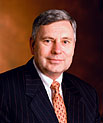

John
R. Colson
President and Chief Executive Officer of Quanta Services, Inc.
President and Chief Executive Officer of Quanta Services, Inc.
Quanta Services, Inc. was formed in 1997 with the merger of four companies. John Colson, the president and chief executive officer of the lead company in that merger, Par Electric Contractors, became president and CEO of the new Houston-based company that provides specialized contracting services to electric utilities, telecommunication and cable operators and governmental entities. The other originating companies, still operating as Quanta companies, are Trans Tech Electric, Union Power Construction and Potelco, Inc.
Three major industry trends drove the merger: deregulation of the electric utility and telecommunications industries; the aging of the existing transmission and distribution infrastructure in the U.S., and the explosive growth of the internet and increased telecommunications traffic. Deregulation and internet-related businesses have hit snags affecting Quanta’s most recent revenues but capital expenditures for transmission and distribution infrastructure by utilities will act as the driver for Quanta’s business well into the future.
Today, Quanta Services is the largest transmission and distribution contractor in the U.S., with 32 operating units located throughout the country. Since 1998, it has bought up an additional 80 companies, many already subcontractors to larger acquisitions. This has helped in the consolidation of the new company, Colson said, which operates on a decentralized basis.
Quanta Services was formed at the time its customers - utilities - were downsizing, reducing budgets and outsourcing most of their work in preparation for deregulation. “We were merging to get a broader customer base,” Colson said. The goal was to merge, go public and acquire other companies. “We also were helping our customers as they expanded into telecommunications and cable businesses. We needed to get that expertise to be a national player,” he added. Quanta Services completed its initial public offering in February 1998 and expanded from 60 customers to more than 300 by the end of that year. Its secondary offering in January of 1999 raised more than $100 million for ongoing acquisitions. Increased outsourcing by the utilities drove the 25.6% annual internal revenue growth experienced between 1996 and 1999 by the companies that comprised Quanta Services at the end of 1998.
Quanta’s net revenues in 1998 were $150 million and reached $2.1 billion in 2001 at the height of the telecommunication industry growth. In 2002, the company’s net revenues declined to $1.75 billion. “Our customers were hurt by the California energy crisis, the Enron bankruptcy and the subsequent drop in energy trading,” said Colson, along with the falloff of investments in the telecommunication and cable industries. As a result, Quanta’s growth rate has stagnated.
Now, at the beginning of 2004, Quanta Services has reached critical mass. “ We serve over 400 customers and are more focused on internal growth and maintaining cash flow,” Colson explained. He predicts spending will return to normal over the next two years.
Looking to future business growth, Colson pointed to the nation’s transmission grid which was built largely after World War II and now needs a major overhaul. It has huge bottlenecks because it was designed for individual markets and not for wheeling power across states. It is also suffering from a lack of maintenance. Colson explained that the transmission grid reached this point because utility balance sheets don’t support grid-rebuilding.
Utilities are still looking at segregated systems and not looking at how to initiate solutions. Initiatives will have to come from outside the utilities, probably at the federal level to move them to action, perhaps in the form of tax incentives, higher rates of return or new rules imposed by the Federal Energy Regulatory Commission, he concluded.